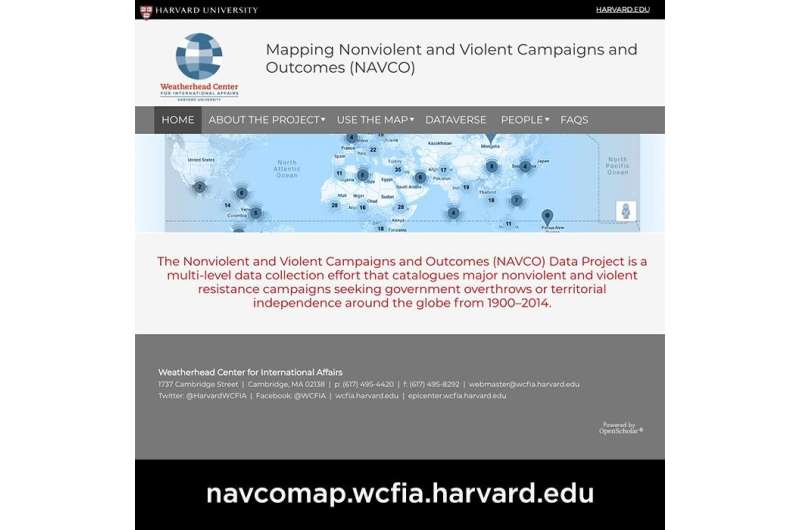Credit: CC0 Public Domain
The Weatherhead Center for International Affairs at Harvard University has launched a new interactive map that catalogs all mass uprisings around the world between 1945-2014. The data, collected by Professor Erica Chenoweth and Fellow Christopher Shay, resoundingly show that nonviolent campaigns are more successful at achieving their political goals than violent campaigns. The findings upend the long-held assumption that only violent insurgencies can bring about large-scale political transformation.
Under the direction of Chenoweth and Shay, The Nonviolent and Violent Campaigns and Outcomes (NAVCO) data project is the first of its kind to collect systematic data on both violent insurgencies and nonviolent civil resistance campaigns. The coverage is global but includes only maximalist campaigns, that is, movements seeking to overthrow an incumbent government, expel a foreign military occupation, or claim territorial independence.
The data project covers hundreds of these campaigns, and the interactive tool allows users to study many factors, including:
- trends in the onset and outcomes of mass mobilizations over time and across regions;
- patterns of participation in mass movements;
- retaliation against mass movements;
- the success or failure of the campaign.
Chenoweth and co-author Maria J. Stephan published their first analysis of the comparative outcomes of nonviolent and violent resistance campaigns in the 2011 book Why Civil Resistance Works: The Strategic Logic of Nonviolent Conflict. In this book, the authors aggregated data from 1900 - 2006 and concluded that, overall, nonviolent civil resistance was more successful in achieving target outcomes than campaigns that use violence. The more recent dataset featured in the interactive tool confirms this trend and extends it into the past decade.
"Many researchers around the world turn to the NAVCO data project to analyze the ways that both nonviolent and violent resistance affect global politics," says Chenoweth. "Chris and I are happy to make the newest version of the data available so that this important work can continue. I am also hopeful that the mapping tool will make the data more accessible to broad audiences who want to see where and how resistance campaigns have taken shape."
Mapping Nonviolent and Violent Campaigns and Outcomes (NAVCO): an interactive map hosted by the Weatherhead Center for International Affairs at Harvard University. https://navcomap.wcfia.harvard.edu/ Credit: Harvard University
More information:
Erica Chenoweth And Maria J. Stephan Why Civil Resistance Works: The Strategic Logic of Nonviolent Conflict
Series: Columbia Studies in Terrorism and Irregular Warfare. Copyright Date: 2011; Published by: Columbia University Press
Pages: 320. www.jstor.org/stable/10.7312/chen15682
Provided by Harvard University
























